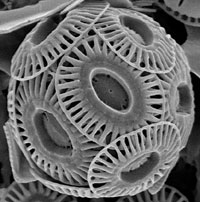


|
The Project Part 3:
Also See: Part 1: Part 2:
|
This project studies an interesting microscopic plant, Emiliania huxleyi, which is a species of phytoplankton found in the ocean. These plant cells contain chemical compounds that are known as “bio-markers.” That means there is something inside the plant cell that can tell us something about the conditions around the cell when it was growing. Even when the cell is no longer living, the internal compound still contains this information. These plant cells have key chemical molecules inside them. These specific key chemical molecules are called “alkenones.” (A molecule is a specific combination of chemical elements. For example, water is a molecule made up of the elements hydrogen and oxygen.) The chemical structure of the alkenone molecule is strongly influenced by the temperature of the water in which the plant cell grows. So, when these plant cells are analyzed, the scientists can figure out what the water temperature was when the plant was growing. The plant cells act like a one-time thermometer! By careful chemical analysis of the alkenone molecules, scientists can “read” the plant cell thermometer. Scientists can get this information from plants that are living in the ocean water or from ones that have died and become part of the mud (sediment) on the bottom of the ocean floor. This is important information for many reasons. It is possible to learn something about the life history of the plant. It is also possible to figure out the temperature of ocean water in the past by examining the alkenones in the mud of the sea floor. So, scientists can learn about biology when they know about the short time of a cell’s life. The scientists also learn about geology and ocean conditions over a long period of time in the Earth’s past.
This special report was made possible by NSF Marine Geology and Geophysics Award Nos. OCE-0326573 to Fredrick Prahl (Oregon State University)and OCE-0324299 to Brian N. Popp (University of Hawaii) for study of "Alkenone Production and Productivity in Contrasting Surface Water Environments in the North Pacific Ocean."
|




